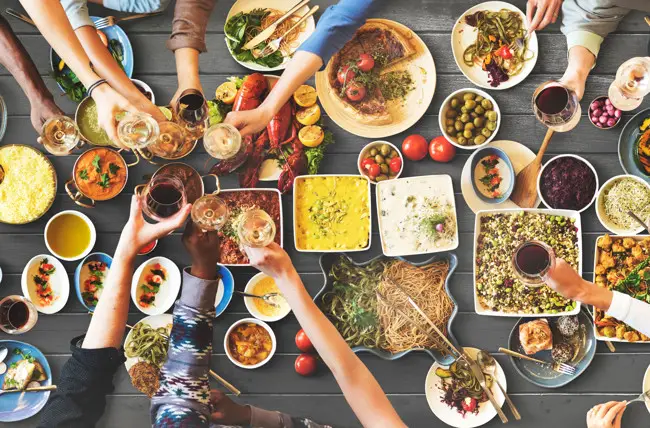It’s hard enough to prepare food for your own family with all of their “I can’t eat anything with green stuff on it,” and “Oh, I didn’t tell you? I’m a ‘porkaterian’ now” bulls**t. Add in a few other kids to the mix, and it’s downright terrifying. So, it makes sense to just forget about this whole baking for others thing and move on. I get it.
If you’re like me, you mostly ignore any and all emails that come from your child’s school for this reason, and many other good ones. You can only read about the latest pinkeye breakout so many times before you embrace the philosophy of, “Let Go and Let God.” And this is how I have mostly avoided providing baked goods for five-plus years of elementary school events! Apparently, God doesn’t want me baking for kindergarteners. Understood.
But I did reconsider my no-baking policy once I learned about a newly diagnosed celiac in our community. I realized that if I didn’t provide some gluten-free chocolate chip cookies, no one would. Except for his parents, of course, but they were probably too busy freaking out about letting their little dude eat in public, much less trying to find a great gluten-free, nut-free, kosher recipe for shortbread. As I began to hear about more and more kids with food allergies and intolerances, I knew that a bake sale without options would be a very sad bake sale, indeed. All of a sudden, I wasn’t the only one walking by the rows of bento box-shaped cookies and luscious pieces of chocolate cake, crying because I would never know the feel of a pecan tart pie crust crunching all around my mouth ever again. The exclusive bake sale treats were no longer only upsetting to me—an adult who, in theory, can tolerate the pain of flaky pastry denial. I knew at that point that I must think about the children. THE CHILDREN!!!! Of course, I also wanted to eat a lemon bar that wouldn’t make me poop my pants, but if I lost control of my bowels, at least it wouldn’t be in front of a group of 8-year-old boys during gym class. Probably. From that point on, I vowed to re-create allergy-friendly treats to offer up whenever I was called upon to do so. This, my friends, is easier said than done. That doesn’t mean that you shouldn’t do it, though.
Go Big or Go Home: Freedom Isn’t Free
You may wonder why I’m throwing out all of the big guns of slogans right now. It’s because it’s so incredibly important to make food safely for kids with allergies. In a totally disgusting way to illustrate this point, I’m actually writing this in between racing to the toilet to destroy the sanctity of my bathroom. You see, I just got back from a school bake sale where I enjoyed a gluten-free cookie (or three) made by a well-meaning(?) parent. Totally had gluten in it, and now I’m missing a much-needed sushi night with my lady friends due to the fact that I cannot be out of the bathroom for more than 5-minute increments. I know that you’re not really feeling me, you people out there who know sushi is for coastal snobs and catfish bait, but stay with me for a minute.
You’re probably wondering how in the world to be mindful of the kids who can’t eat everything, while also not embarrassing yourself with some dried-out quinoa cookies wrapped up in shimmery blue cellophane. Hey, at least the wrapping looks good! The fact is that the most allergy-friendly treats for masses of children are going to be the ones with simple ingredients that are naturally allergy-free. I’m talking fruits, vegetables, limited nonoffending grains such as rice, and if you aren’t vegan—meat. Mmmm, meat treat. Keep it naturally safe, and you’ll have a load of easy recipes to trot out and zero headaches about any complicated substitutions that may or may not be safe for every single kid in attendance. For example, some gluten-free flours contain dairy, and some butter substitutes contain soy. Not to mention that, once you start removing things like gluten and dairy, sometimes you need to add sugar. Mmmm, delicious sugar. But not so awesome if you’re filling up your allergic kids with sugar in lieu of other things all the time. Sometimes? Special occasions? You bet. But not every day, because you’ll have a host of other problems on your hands. Still, there’s a reason I have recipes for cakes, pies, and hot dog buns, and that reason is that I want to eat those things. And so do kids!
This is why we’re here, right? We want cake, and we don’t want it to harm anyone. So let’s dig into these baked-good recipes that you can enjoy at home when your daughter’s allergic BFF comes over, or you can make in bulk and take to the bake sale with confidence. Some recipes will cover all of the eight allergens, some will cover most, but you can mix and match your allergens with help from my handy-dandy substitutions list below, where I help you make a dairy-filled cake dairy-free and teach you how to fake eggs (among other tricks of the allergic trade) and understand why sometimes it’s go egg or go home (I’m looking at you, lemon bars). These special treats will be what you trot out for birthday parties and classroom celebrations from now on, because YUM.
How to Not Screw Up
There are many ways to screw up in the kitchen, and, believe me, I’ve done most of them. We’re still trying to get that chocolate-barbecue sauce off my kitchen ceiling. It becomes very crucial to avoid screwing up, however, when you’re handling food for kids who could react badly to an allergen. Crucial. While you’re preparing these allergy-free recipes, please keep the following in mind.
Wrap It for Safety
You must prepare allergy-free food on clean surfaces and in clean pots, pans, and baking sheets. You absolutely cannot boil some gluten-free pasta for your mac and cheese in the same pot you just used to boil up your gluten-filled pasta. You cannot bake an egg- and dairy-free cookie on a sheet that has been habitually used to bake cookies chock-full of eggs and dairy without covering it with parchment or scrubbing it so hard you probably scrub off the nonstick surface. You can scrub pots and pans within an inch of their lives, but if they have even a crumb of allergen left over, it’s possible it will stick on your nice, allergy-free dough. You also cannot bake nut-filled cookies on the same sheet as their nutless brothers and sisters. This may sound like a pain, so I have two words that will make it much easier to keep things clean and separate: aluminum foil. Oh, and two more: parchment paper.
Before you bake, cover your bakeware with aluminum foil, or parchment paper for the cookies that stick. Before you grill, place aluminum foil down on the grill that will hold your allergy-free options. If you don’t have a cutting board, or very clean surface to prepare your safe food, put down aluminum foil or parchment paper. Your new best friend is aluminum foil. Get to know him, along with his BFF, parchment paper.
No Holding Hands or PDA
When you’re preparing food, keep the allergens far away from the allergen-free ingredients. If they get mixed up, your allergen-free dish is toast. Don’t use the same cutting board for fish that you do for chicken, if you have a fish-allergic guest. Also, don’t think fish is a great ingredient for a school bake sale or a 6-year-old birthday party. That’s a mistake you’ll only make once.
Additionally, don’t let all this hard work keeping surfaces bleached and ingredients separate go to waste by serving up all of your safe food on a platter alongside the dangerous food. Continue to keep these foods separate, using separate cooking pots, pans, and sheets, as well as separate utensils. Consciously uncouple the allergy-laden from the allergy-free foods to make sure that the end result is safe for all.
Whew! That’s a lot, but if you remember to keep your allergy-safe treats safe from the first time you pick up the ingredients until they are safely delivered to the sale, you’ll make a heck of a lot of kiddos happy, as well as their very anxious parents. It’s like farm to table, but without the hipster element.
A much more exhaustive list of allergy-friendly products lives in the resource section of [Bake Sales are My B*tch], but if you want to get started baking right away, here are a few items to consider stocking in your pantry before you put on your allergen-free apron. (Okay, that’s not a real thing, so don’t panic. Any old apron without clumps of food on it will do.)
Baking Substitutes for Common Allergens
Butter Substitutes
Earth Balance: This vegan butter alternative comes in many forms, but you’ll most likely be picking up the baking sticks. If you’re making a soy-free treat, do not buy the buttery baking sticks, but instead pick up the soy-free version.
Nutiva Organic Vegan Superfood Shortening: This soy-free, dairy-free, gluten-free, GMO (genetically modified organism)-free, fair-trade product is a combination of red palm oil and virgin coconut oil. You can find a million different coconut oils on the market, but Nutiva’s combination with palm oil makes it a better option for baking when you’re avoiding the eight main allergens.
Crisco Vegetable Shortening, Butter Flavor: I grew up using Crisco butter flavor in so many family recipes that I naturally tried it first when I went about experimenting with dairy-free baked goods. While my family probably used Crisco as a butter substitute for completely different, now-defunct reasons (it was the 1980s, and butter was the enemy), it does hold up in recipes pretty well. Crisco contains soy, along with artificial flavors, so if you’re not on board with either of those, you should probably try Spectrum organic all-vegetable shortening. The main ingredient in both vegetable shortening brands is also palm oil.
Egg Substitutes
Ener-G Egg Replacer: The OG of egg replacement, Ener-G has been helping out egg-free bakers for a very long time. If you’re going to be baking egg-free a lot, I would suggest grabbing a box and going to town. Since it’s also eight main allergen-free, it’s a good substitute for the kids.
Golden Flax Meal: Flax meal has become my go-to for baking without eggs. You combine 1 tablespoon of flax meal with 3 tablespoons of water per egg called for in the recipe. The key is in letting it sit for a little while before you use it. (I say at least 10 minutes, but if you have a half-hour to wait, do that for optimum egglike properties.) You can either buy the golden flaxseeds and grind them in a coffee grinder when you’re ready to use them, or buy the meal and keep it sealed up tight so it will retain its freshness.
Chia Seeds: Chia seeds work in the same manner as flaxseeds, and are truly gelatinous. My only issue is if you’re creating something light in color, you can get a little black spot action in the final product. Both work well, so go with what you like.
Follow Your Heart VeganEgg: What’s great about this all allergen-free product is that you can even cook this up and make an omelet if you’ve been craving one since you had to go egg-free.
Baking Soda and Vinegar: I’ve used the baking-soda-and-vinegar combo in a pinch and, while it didn’t seem to work as well as the magic flax meal, it’s definitely serviceable in your baked goods. Combine 1 teaspoon of baking soda and 1 tablespoon of vinegar (watch, as it will bubble up), allow to dissolve, and you have a substitute for 1 egg.
Gluten Substitutes
Cup4Cup: For baking, I’ve always loved Cup4Cup multi-purpose gluten-free flour, but it will not work as a flour in the dairy-free recipes, as one of the ingredients is milk powder. I also like to use all-purpose flours so I don’t have to experiment with xanthan gum or add anything else to the mix. It makes it easier, and that makes me happier.
Better Batter: Luckily, my other favorite gluten-free, all-purpose flour is dairy-free (and every other allergen-free, plus kosher), and it also gives fantastic results. It’s become one of my go-tos now that I’m experimenting with gluten- and dairy-free recipes, but it is sadly harder to find than many other popular brands. I recommend ordering online and stocking up if you’re going to be the bake-sale queen.
King Arthur Gluten-Free All-Purpose: Another great gluten- and dairy-free option, I also love to use King Arthur’s recipes. It’s a solid choice, and I almost always have a box in my cupboard.
Almond Meal: Only if you know there are no nut allergies around, almond meal makes for some delicious cakes. The texture is lovely and moist, and the slight nutty flavor can enhance any cake recipe. You do have to experiment with it, unlike the all-purpose flours above, but if you’re 100-percent sure that you don’t need to keep it tree nut-free, have some fun with the almond flour family.
Milk Substitutes
The trouble with milk substitutes in baking is the lack of eight main allergen-free options if (and this is a pretty big if) you have a coconut problem. While rice milk fits the bill, it is not as rich and appropriate for baking as coconut milk cream and coconut milk are. Soy milk and nut milks are also great substitutes, but have the obvious problem of being in the eight main allergen family.
I generally recommend coconut cream and coconut milk regardless, as a coconut allergy as part of a tree-nut allergy is so incredibly rare. And when it comes to baked goods, coconut milk does have the best result in a recipe. Still, be sure you know the specifics of any allergies kids may have before you start to mix up your eight main allergen-free brownies.
One more note for the bake-sale bakers: If you’re preparing food for a party, bake sale, or anywhere that you will be dropping off and not sticking around to explain what’s up with your cookies, label your treats. Let the dairy-free know if something is safe to eat by being very clear with your packaging. After all, what’s the point of making allergy-friendly treats if no one knows about it? (Note to parents of the severely allergic: You still don’t want to risk homemade treats from someone’s kitchen unless you’ve had a very detailed convo and know without a doubt that they’re safe for your kiddo. But you knew that already, I’m sure.)
Now, stock up on your cellophane and decorative twine…it’s bake sale time!
Recipes for Eight Main Allergen-Free Treats
Recipe Key
Gluten (G), Dairy (D), Peanuts (P), Tree Nuts (TN), Soy (S), Egg (E), Fish (F), and Shellfish (SF)—means it is free of these allergens.
Snickerdoodles
G, D, P, TN, S, E, F, SF (8/8)
Another benefit to growing up in 1980s Oklahoma is that my mom and grandmother often used oleo instead of butter. If you don’t know what oleo is, just know that you could totally substitute Earth Balance or butter-flavored vegetable shortening and be in business. The point is, this is my mom’s recipe, which is naturally dairy-free, since she used that super-trendy oleo. I’ve made it gluten-free and egg-free, as well. You can always use butter, regular flour, and 2 eggs, if you’re not entertaining any allergic types.
Prep time: 15 minutes • Chill time: 3 hours • Cook time: 8 minutes • Makes: 24 servings
Ingredients:
- 2 tablespoons golden flax meal
- 1 cup Earth Balance or butter-flavored vegetable shortening
- 1¾ cups sugar
- 1¾ cups all-purpose gluten-free, dairy-free flour
- 2 teaspoons cream of tartar
- 1 teaspoon baking soda
- ½ teaspoon salt
- 2 teaspoons cinnamon
Directions:
- In a small bowl, whisk together flax meal and 6 tablespoons water. Allow to stand for 10 minutes.
- Using an electric mixer or stand mixer, cream butter substitute or shortening and 1½ cups sugar. Add flax meal and water mixture and combine well. Add flour, cream of tartar, baking soda, and salt, and mix well.
- Transfer dough to refrigerator and chill for 3 hours or more.
- Preheat oven to 400°F and prepare baking sheet by lightly spraying with vegetable oil spray.
- In a small bowl, combine cinnamon and the remaining ¼ cup sugar well.
- Remove chilled dough from refrigerator and roll dough into balls 1½ to 2 inches in diameter. Roll balls in cinnamon and sugar mixture and place on baking sheet.
- Bake for 8 minutes, or until edges are golden brown.
Popcorn Balls
G, D, P, TN, S, E, F, SF (8/8)
This is my grandmother’s recipe that my mother always made as well, and now I’m carrying on this naturally gluten-free, dairy-free, and every other “-free” treat. If you use butter to shape the balls, this recipe will no longer be dairy-free. Getting out the candy thermometer may seem like a pain, but it’s 100 percent worth it to get the precise temperature for this recipe. For holiday bake sales, you can add a few drops of food coloring to get the right holiday hue. I like to dress up popcorn balls with a chocolate drizzle or a quick roll in crushed candies. If those ingredients float your boat, I suggest you do the same.
Prep time: 10 minutes • Cook time: 20 minutes • Makes: 12 balls
Ingredients:
- 12 cups plain popped corn
- 2 cups sugar
- ½ cup corn syrup
- 1 teaspoon apple-cider vinegar
- ½ teaspoon salt
- 1 teaspoon vanilla extract
- Vegetable oil or Earth Balance
Directions:
- Place popcorn in a large bowl and set aside.
- In a medium saucepan, combine sugar, 1½ cups water, corn syrup, vinegar, and salt and heat on medium-high heat. Continue stirring occasionally until candy thermometer reads 240°F (hard-ball stage). Stir in vanilla and combine well.
- Pour mixture over popcorn and mix well.
- Working quickly, use vegetable oil or butter substitute on your hands to help shape popcorn into 3-inch balls. Place balls on a baking sheet and allow to cool. Caution: Mixture will be hot; do not let little hands help with this step.
Cupcake Bowls with Fruit Filling
G, D, P, TN, S, E, F, SF (8/8)
A festive-looking and allergy-friendly dessert, cupcake bowls are also an incredibly easy treat to make for a crowd. Heck, I even employ the kids when I’m making cupcake bowls, because I know that they’ll enthusiastically dig into the cupcake tops, because they want to eat the pieces that “fall off” during the process. I prefer to fill these up with mixed berries and a sprig of mint with a drizzle of chocolate sauce on top, or a crumble of the leftover cupcake tops. But you do you.
Prep time: 15 minutes • Cook time: 30 minutes • Makes: 24 cupcakes
Cupcakes:
- 1½ cups all-purpose gluten-free, dairy-free flour
- 1 cup sugar
- 3 tablespoons cocoa powder
- 1 teaspoon baking soda
- ½ teaspoon salt
- 1 teaspoon apple-cider vinegar
- 1 teaspoon vanilla extract
- 5 tablespoons vegetable oil
Filling:
- 3 cups mixed fresh berries
- ½ cup sugar
- Chocolate sauce and mint sprigs (optional)
- Preheat oven to 350°F and line 2 muffin pans with paper cupcake liners.
- Make the cupcakes: In a large bowl, whisk together flour, sugar, cocoa powder, baking soda, and salt. Set aside.
- In a medium bowl, mix together vinegar, vanilla, oil, and 1 cup water.
- Create a well in the dry ingredients and pour in wet ingredients, and combine. Pour batter into muffin pans.
- Bake for 30 minutes, or until toothpick comes out clean from center of test cupcake.
- Remove from oven and allow to cool for 15 minutes.
- Make the filling: In a medium saucepan, combine berries, sugar, and 1⁄4 cup water, and mix well. Bring mixture to a boil and allow it to boil for 5 minutes, stirring regularly. Remove from heat and set aside to cool.
- Remove cupcakes from liners and line up on a serving platter.
- Using a small ice cream scoop or large spoon, scoop out the center of the cupcakes and set aside the crumbs.
- Evenly distribute the berry mixture inside each “bowl.”
- Drizzle with chocolate sauce and add a sprig of mint, if desired, or crumble leftover cupcake crumbs on top and serve.
Fun Tip: Fill these up with ice cream of your choice and add fruit on top with chocolate syrup for cupcake sundaes at your next birthday party.
 |
Reprinted from Bake Sales are My B*tch by April Peveteaux. Copyright (c) 2016 by April Peveteaux. By permission of Rodale Books. Available wherever books are sold. |
RELATED:
Find More of Our Favorite Recipes
Search for a Nutritionist Near You




















